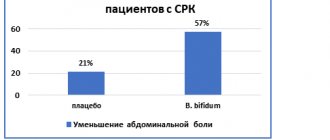Moderate hepatomegaly: causes, symptoms, diagnosis and treatment Moderate hepatomegaly is a disease in which diffuse changes in the liver are observed (i.e. the organ is pathologically enlarged). Of course, organ enlargement is not critical, but this disease cannot be left untreated either. The disease is the result of the presence of such serious diseases as cirrhosis, hepatitis and even heart failure.
All age groups are susceptible to the disease, but children under 6 years of age have moderate hepatomegaly as the norm. Of course, even these standards have strict limits:
- up to 6 months – liver protrusion 3 cm below the right hypochondrium;
- 6 months - 2 years - liver protrusion no more than 1.5 cm;
- 2 years 7 years – liver protrusion no more than 1 cm.
If the indicators differ, you should immediately seek medical help.
Causes
A moderate increase in liver size can develop due to both natural and pathological causes. Minor changes in the shape and tissues of the organ can be caused by eating fatty foods, pickles, smoked foods and other unhealthy foods. Regular consumption of alcoholic beverages in significant quantities also leads to liver enlargement.
Dangerous, pathological causes of changes in the size of an organ are such diseases occurring against the background as:
– hepatitis A, B, C, as well as granulomatous hepatitis;
– disturbances in the course of metabolic processes – disturbances in the metabolism of proteins, lipids, glycogen, Wilson’s disease;
– liver fibrosis;
– cirrhosis;
– hemolytic disease – in newborns;
– parasitic organ damage;
– congenital infections – rubella, cytomegalovirus, herpes, etc.;
– hypervitaminosis, sepsis;
– cancerous conditions of the liver – lymphomas, metastases, hepatomas, etc.
Liver damage in children
Liver diseases are accompanied by a number of clinical syndromes. The following symptom complexes are more common: inflammation of the liver tissue, portal circulation disorders, symptom complex of acute and chronic liver failure, etc. A good children's doctor is the Markushka clinic.
Inflammation of the liver tissue in children
The symptom complex of inflammation of the liver tissue is a combination of morphological, physiological and metabolic changes that occur in the body in response to the action of various factors damaging the liver: biological (viruses, bacteria, fungi, immune complexes, etc.), toxic, physical, etc. It includes a number syndromes: cytolytic, mesenchymal-inflammatory, cholestatic, hepatoprivate.
Cytolytic syndrome occurs due to disturbances in the structure of liver cells. These disorders are sometimes limited only to cell membranes, but more often extend to the cytoplasm and affect individual cells as a whole. Cytolysis is one of the main indicators of the activity of the pathological process in the liver.
Hepatocellular failure syndrome is characterized by fever, weight loss, jaundice, hemorrhagic diathesis, extrahepatic signs: “hepatic tongue”, “liver palms”, “spider veins”, changes in nails, hair growth, gynecomastia, etc. A decrease in albumin levels is observed in the blood , cholesterol, concentrations of components of the blood coagulation and anticoagulation system (prothrombin, factors V, VII, fibrinogen, etc.), increased bilirubin levels, signs of impairment of other liver functions.
It has been shown that in mild acute and chronic liver diseases there are no significant changes in cholesterol levels. At the same time, with moderate and especially severe liver damage, a clear decrease in cholesterol levels is observed, which is an alarming signal indicating the possibility of developing hepatocellular failure .
Mesenchymal inflammatory syndrome indicates the activity of the pathological process in the liver. Clinically characterized by fever, arthralgia, lymphadenopathy, splenomegaly, vasculitis (skin, lungs).
Cholestatic syndrome is characterized by either a primary (dysregulation of the actual bile-secreting mechanisms of hepatocytes) or a secondary disorder of bile secretion. A secondary disorder of bile secretion develops in cases of biliary hypertension, which in turn is associated with an obstruction to the normal flow of bile in the biliary tract. Clinical manifestations: persistent skin itching, jaundice, skin pigmentation, xanthelasma, darkening of urine, lightening of stool.
Portocaval liver shunt syndrome, “disconnected” liver syndrome . Indicators of liver shunting are substances that normally flow primarily from the intestines into the portal vein system and liver. Under pathological conditions, bypassing the liver (with the development of venous collaterals), these substances enter the general bloodstream system. The concentration of these substances, therefore, in the blood serum increases sharply with portacaval shunting, which indicates in favor of the “disconnected” liver syndrome.
Acute liver failure, hepatic coma in children
Acute liver failure . Defined as an acute and progressive deterioration in liver function, develops in children mainly with malignant forms of viral hepatitis B, C, D or other diffuse liver damage, acute poisoning, as a complication of previous congenital diseases, anatomical or metabolic disorders. In young children, it often develops due to viral hepatitis (B, C, D), poisoning with hepatotropic poisons (mushrooms - toadstool, stringworms, fly agarics, etc.). Vaccination of children against hepatitis B at the Markushka children's clinic.
The development of the clinical syndrome of acute liver failure is indicated by the atypical course of hepatitis: persistent loss of appetite, increasing jaundice, a drop in the prothrombin index, a decrease in the levels of albumin and fibrinogen in the serum, changes in the child’s behavior in the form of adynamia, apathy, drowsiness, less often - agitation, anxiety. From the mouth, from sweat and urine, a sweetish smell is felt - “liver”. The size of the liver begins to decrease. Encephalopathy may develop several days after the onset of the disease. The etiological factor in the occurrence of hepatic encephalopathy and coma is a number of toxins - ammonia, mercaptans, fatty and aromatic acids.
There are 4 stages of hepatic coma :
1st - change in emotional reaction (euphoria); 2nd - confusion and disorientation, reaction to simple commands persists; 3rd - stuporous state, the reaction to painful stimuli persists; 4th - comatose state, decortication position, no reaction to painful stimuli; possible development of cerebral edema.
Chronic liver failure develops gradually and is often the terminal outcome of chronic liver diseases (chronic hepatitis B, D, C, etc.).
Hepatomegaly, enlarged liver in a child, children
Hepatomegaly . The liver in newborns and children of the first year of life protrudes from the hypochondrium by 1-2 cm. The physiological norm is the location of the liver 1 cm below the costal arch in preschool children. Hepatomegaly, an enlarged liver, is the most common symptom of liver disease. As a manifestation of visceroptosis in people of asthenic physique, in a number of diseases (including rickets, myopathies, etc.), the edge of the liver can protrude 1-3 cm downward from the costal arch in children of different ages. Pathological enlargement of the liver can be due to various reasons.
An enlarged liver of infectious origin can occur in acute and chronic diffuse liver diseases (viral hepatitis A, B, C, D), infectious mononucleosis, sepsis, diphtheria (diphtheria vaccinations for children - Markushka Clinic), scarlet fever, generalized tuberculosis, abdominal , typhus, relapsing typhus, brucellosis, congenital syphilis, malaria, parasitic diseases (echinococcosis, giardiasis, amebiasis, toxoplasmosis). Diseases of the heart and lungs (myocarditis, congenital heart defects, pneumonia, etc.) in children as a result of the development of right ventricular failure lead to a significant enlargement of the liver (“cardiac liver”). Mantoux test in children (tuberculin test) - medical.
Hepatomegaly is a constant symptom in blood diseases (leukemia, non-Hodgkin's lymphomas, lymphogranulomatosis, histiocytosis X, hemolytic anemias, Jaksha-Hayem syndrome), in primary tumors (malignant hepatoma - hepatocellular cancer with a high content of alpha-fetoprotein in the blood, cavernous hemangioma, sarcoma , liver cyst, echinococcal cysts) or tumor metastases (neuroblastoma, lymphogranulomatosis and leukemia, adenocarcinoma, etc.)
The cause of hepatomegaly can be storage diseases: lipidosis, cerebrosidosis, glycogenosis, metabolic diseases. Chronic nutritional disorders (protein deficiency with abundant consumption of fats and carbohydrates), diabetes mellitus, are accompanied by an enlarged liver.
An enlarged liver can simulate a subdiaphragmatic abscess, pulmonary emphysema (low position of the liver), diaphragmatic hernia, pneumoperitoneum. Hepatomegaly is observed with cholestasis and inflammation of the biliary tract (blockage with a stone, tumor, parasite, biliary atresia, cholangitis, etc.). Analysis of child's stool - Markushka Clinic.
Symptoms
Signs of moderate hepatomegaly due to minor changes in the size of the organ are weakly expressed. Symptoms may not appear at all for a long time. Many patients do not even suspect that they have a pathological liver condition. The disease is most often diagnosed accidentally when a person undergoes an examination for a completely different reason. So, during an ultrasound of the pelvic or abdominal organs, the doctor identifies echo signs that indicate an increase in liver volume.
In some cases, signs of moderate hepatomegaly still appear.
A patient with this diagnosis will feel:
– heaviness and feeling of constriction in the lower part of the right hypochondrium;
– pain in the above area upon palpation;
– mild nausea;
– the skin may acquire a jaundiced tint;
– general health will worsen.
Due to the fact that the signs of moderate hepatomegaly are nonspecific, many people attribute the discomfort to malaise, fatigue, or banal poisoning. However, doctors advise not to delay visiting the clinic. This will allow the disease to be diagnosed in time and treatment of moderate hepatomegaly to be started in order to avoid more dangerous consequences. Ignoring contact with a qualified specialist increases the likelihood of scarring of healthy liver parenchyma tissue. This will lead to the formation of cysts and other pathological formations.
Hepatosplenomegaly (Hepatolienal syndrome)
A gastroenterologist can suspect hepatosplenomegaly during a routine examination: during palpation and percussion, enlarged sizes of the liver and spleen are revealed. Such a simple research method as percussion (tapping) allows one to differentiate prolapse of the abdominal organs from their true enlargement.
Normally, upon percussion of the liver, its upper border is determined at the level of the lower edge of the right lung. The lower border starts from the edge of the X rib (along the right anterior axillary line), then passes along the edge of the costal arch on the right, along the right parasternal line - two centimeters below the costal arch, along the midline - 5-6 cm below the xiphoid process, the border of the liver is not extend beyond the left parasternal line. The transverse size is 10-12 cm, gradually tapering towards the left edge to 6-8 cm.
Percussion of the spleen can present certain difficulties due to its small size and close proximity to the stomach and intestines (the presence of gas in these organs makes percussion difficult). Normally, splenic dullness is determined between the IX and XI rib, is about 5 cm in diameter, the length should not exceed 10 cm.
Palpation of the abdominal organs is a more informative method. It should be remembered that a tumor of the right kidney, colon, or gall bladder can be mistaken for an enlarged liver. Emphysema, subphrenic abscess, right-sided pleurisy can provoke hepatoptosis, due to which the lower edge of the organ will be palpated significantly below the edge of the costal arch, although the true size will not be increased. Palpation of the spleen should be done in a position on the right side. Splenomegaly can be imitated by prolapse of the left kidney, tumors and cysts of the pancreas, and neoplasms of the colon.
Consultation with a gastroenterologist is indicated for all patients diagnosed with hepatosplenomegaly. The diagnostic search is aimed at identifying the disease that led to the enlargement of the liver and spleen. It includes:
- Laboratory research.
Clinical blood tests and biochemical liver tests can detect damage to the liver tissue, hematological diseases, viral hepatitis and other infectious and parasitic diseases. - Instrumental visualization.
Ultrasound of the abdominal organs, MRI of the liver and biliary tract, MSCT of the abdominal organs allow not only to accurately diagnose the degree of enlargement of the liver and spleen in hepatosplenomegaly, but also to detect concomitant pathology of other abdominal organs. - Liver puncture biopsy.
In difficult diagnostic situations, under local anesthesia, the liver tissue is punctured with a thin needle and material is collected for histological examination. This technique is invasive, but allows an accurate diagnosis of liver damage. - Angiography.
It involves the introduction of a radiopaque substance into the vessels of the liver and spleen, followed by an assessment of their architectonics and portal blood flow. - Other punctures and biopsies.
If hematological pathology is suspected, a bone marrow puncture and lymph node biopsy are performed.
The combination of hepatosplenomegaly with changes in liver tests indicates damage to the liver parenchyma and storage diseases. Detection of lymphomyeloproliferative processes and changes in the general blood test indicates hematological pathology. Characteristic symptoms and clinical picture of damage to the cardiovascular system allow one to suspect congestive heart failure.
CT OBP. Diffuse enlargement of the liver (green arrow) and more pronounced enlargement of the spleen (red arrow).
Treatment
It is possible to restore the normal size of the liver in a moderate form of the disease through diet therapy and taking hepatoprotective medications aimed at protecting the liver, as well as vitamin complexes and enzymes.
It is recommended to strictly follow the diet.
The following should be excluded from the diet:
- alcohol;
– fried, spicy, fatty, salty and spicy dishes;
– canned food and marinades;
– carbonated sweet drinks;
– dairy products with a high fat content – butter, cream, sour cream over 20%, ice cream, cheese.
You need to eat small portions 5 times a day. The main menu should include boiled vegetables and fruits, water porridge, lean meats and fish.
Hepatosplenomegaly symptoms
In the case of the development of a disease such as hepatosplenomegaly, the symptoms of liver enlargement are often combined with signs of the underlying pathological process. Careful clarification of the patient's complaints and professional history taking allow for differential diagnosis between one or another disease and establishment of a prostate diagnosis. The most common signs of hepatosplenomegaly are:
- a feeling of heaviness and fullness in the area of the right and left hypochondrium;
- pain in the liver area;
- yellowness of the skin;
- tendency to bleeding, manifested in frequent nosebleeds, the formation of extensive hematomas with minor exposure;
- identification of a tumor-like formation in the area of the right hypochondrium that moves during breathing;
- an increase in the size of the abdomen with the development of ascites.
↑ Top | Applying for treatment ↓
Advantages of treating hepatosplenomegaly in Israel
The advantages of treating hepatosplenomegaly in Israeli clinics are:
- attentive attitude and individual approach to each patient;
- high-quality comprehensive examination;
- differentiated approach to the treatment of various types of hepatosplenomegaly;
- consultations with experienced specialists;
- use of innovative drugs and modern therapeutic techniques.
Hepatosplenomegaly is a serious symptom of problems in the body and therefore requires timely seeking highly qualified medical care.
Hepatosplenomegaly treatment
Israeli specialists provide high-quality medical care to patients with hepatosplenomegaly. The first stage of treatment in this case is a full examination, which makes it possible to establish the cause of the pathological process and draw up a treatment program. In the case of such a pathological condition as hepatosplenomegaly, treatment is aimed at eliminating the underlying disease that led to an enlargement of the liver and spleen, for example, cirrhosis, hepatitis, leukemia.
- Detoxification therapy involves the use of drugs that cleanse the blood of toxic metabolic products.
- Antiviral therapy – used in the treatment of patients with hepatitis and other infectious diseases.
- Hormonal therapy - has a general anti-inflammatory effect and suppresses the development of many pathological processes.
- Hepatoprotective therapy is used to facilitate the functioning of the liver and restore its functions.
- Symptomatic therapy – the use of choleretic, analgesic drugs, antispasmodics, probiotics can alleviate the patient’s condition and improve his quality of life.
- – cytostatic drugs are used to treat those patients whose hepatosplenomegaly is caused by the development of hematological diseases.
- Cell therapy is a treatment method that is widely used to treat leukemia.
↑ Top | Applying for treatment ↓







